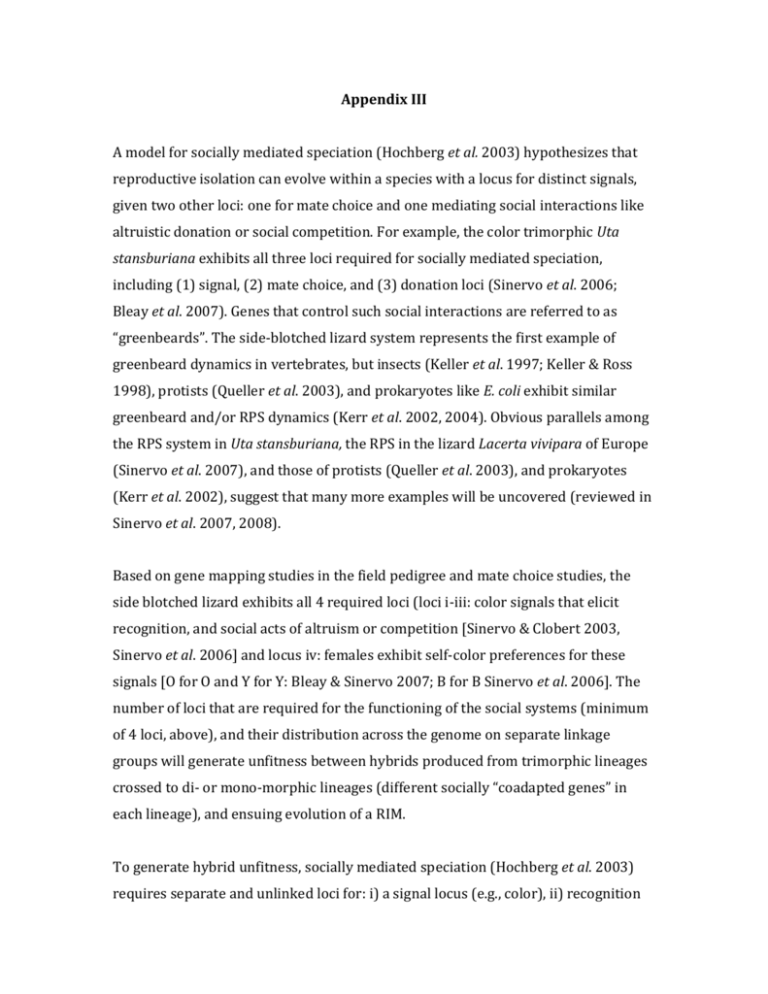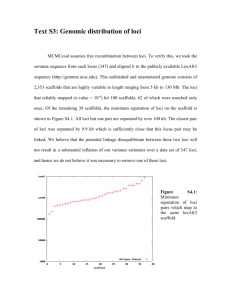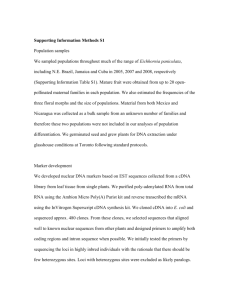MEC_4722_sm_AppendixS3
advertisement

Appendix III A model for socially mediated speciation (Hochberg et al. 2003) hypothesizes that reproductive isolation can evolve within a species with a locus for distinct signals, given two other loci: one for mate choice and one mediating social interactions like altruistic donation or social competition. For example, the color trimorphic Uta stansburiana exhibits all three loci required for socially mediated speciation, including (1) signal, (2) mate choice, and (3) donation loci (Sinervo et al. 2006; Bleay et al. 2007). Genes that control such social interactions are referred to as “greenbeards”. The side-blotched lizard system represents the first example of greenbeard dynamics in vertebrates, but insects (Keller et al. 1997; Keller & Ross 1998), protists (Queller et al. 2003), and prokaryotes like E. coli exhibit similar greenbeard and/or RPS dynamics (Kerr et al. 2002, 2004). Obvious parallels among the RPS system in Uta stansburiana, the RPS in the lizard Lacerta vivipara of Europe (Sinervo et al. 2007), and those of protists (Queller et al. 2003), and prokaryotes (Kerr et al. 2002), suggest that many more examples will be uncovered (reviewed in Sinervo et al. 2007, 2008). Based on gene mapping studies in the field pedigree and mate choice studies, the side blotched lizard exhibits all 4 required loci (loci i-iii: color signals that elicit recognition, and social acts of altruism or competition [Sinervo & Clobert 2003, Sinervo et al. 2006] and locus iv: females exhibit self-color preferences for these signals [O for O and Y for Y: Bleay & Sinervo 2007; B for B Sinervo et al. 2006]. The number of loci that are required for the functioning of the social systems (minimum of 4 loci, above), and their distribution across the genome on separate linkage groups will generate unfitness between hybrids produced from trimorphic lineages crossed to di- or mono-morphic lineages (different socially “coadapted genes” in each lineage), and ensuing evolution of a RIM. To generate hybrid unfitness, socially mediated speciation (Hochberg et al. 2003) requires separate and unlinked loci for: i) a signal locus (e.g., color), ii) recognition loci for (self) signals, iii) signal recognition elicits social acts of altruism (to self) or competition (to non-self), and iv) females exhibit (loci) preferences for self (color signals). Even though these loci are unlinked, in spatially prescribed neighborhoods, the model reproducibly generates species with differently colored signals eliciting social acts in one species versus the other. Reduced hybrid fitness at junction between evolving species leads to the selection of mating preferences, which then spread to the core areas of the respective species (Hochberg et al. 2003). The number of loci that are required for the functioning of the social systems (minimum of 4 loci, above), and their distribution across the genome on separate linkage groups will generate unfitness between hybrids produced from trimorphic lineages crossed to di- or mono-morphic lineages (different socially “coadapted genes” in each lineage), and ensuing evolution of a RIM. The process of coadapted mate preferences (e.g., preference for the same color morph: Bleay & Sinervo (2007) is amplified by multi-trait preferences involving color and many other loci (Lancaster et al. 2009). Therefore, the levels of linkage disequilibrium due to correlation selection (Sinervo & Svensson 2002), mate preference (Bleay & Sinervo 2007; Lancaster et al. 2009) within an RPS mating system are extremely high (Sinervo et al. 2006), rivaling the linkage disequilibrium found at a contact zone between species. Fixation and loss of color morphs is expected to result in extremely rapid genetic change (Corl et al. 2010a, b) because many other alleles at loci besides the master morph locus will be lost as the alternative optima for the now missing color alleles disappear. Thus, the genes present in a reduced mating system with fewer morphs will be dramatically different than the ancestral RPS system, perhaps generating Dobzhansky-Muller incompatibilities. The formation of Dobzhansky-Muller incompatibilities increases with the number of genes that diverge and with the number of associations among genes (Coyne & Orr 2004), so the loss of a morph could potentially generate a large number of incompatibilities (given the number of autosomal strategic loci with which the OBY locus interacts, Sinervo et al. 2006). References Bleay C, Comendant T, Sinervo B (2007) An experimental test of frequency dependent selection on male mating strategy in the field. Proceedings of the Royal Society B Biological Sciences, 274, 2019–2025. Bleay C, Sinervo B (2007) Discrete genetic variation in mate choice and a condition dependent preference function in the side blotched lizard: Implications for the formation and maintenance of co-adapted gene complexes. Behavioral Ecology, 18, 304–310. Corl A, Davis AR, Kuchta SR, Comendant T, Sinervo B (2010a) Alternative mating strategies and the evolution of sexual size dimorphism in the side-blotched lizard, Uta stansburiana: a population-level comparative analysis. Evolution, 64, 79–96. Corl A, Davis AR, Kuchta SR, Sinervo B (2010b) Selective loss of polymorphic mating types is associated with rapid phenotypic evolution during morphic speciation. Proceedings of the National Academy of Sciences of the USA, 107, 4254–4259. Coyne JA, Orr HA (2004) Speciation. Sinauer Associates, Inc., Sunderland. Hochberg M, Sinervo B, Brown S (2003) Social-mediated speciation. Evolution, 57, 154–158. Keller L, Sundström L, Chapuisat M (1997) Male reproductive success: paternity contribution to queens and workers in Formica ants. Behavioral Ecology and Sociobiology, 41, 11–15. Keller L, Ross KG (1998) Selfish genes, a green beard in the red fire ant. Nature, 394, 573–575. Kerr B, Riley MA, Feldman MW, Bohannan BJM (2002) Local dispersal promotes biodiversity in a real-life game of rock-paper-scissora. Nature, 418, 171–174. Kerr B, Godfrey-Smith P, Feldman MW (2004) What is altruism? Trends in Ecology and Evolution, 19, 135–140. Lancaster L, Hipsley C, Sinervo, B (2009) Female choice for optimal combinations of multiple male display traits increases offspring survival. Behavioral Ecology, doi:10.1093/beheco/arp088. Queller DC, Ponte E, Bozzaro S, Strassmann SE (2003) Single-gene greenbeard effects in the social amoeba, Distylostelium discoideum. Science, 299, 105–106. Sinervo B, Chaine A, Clobert J, Calsbeek R, McAdam A, Hazard H, Lancaster L, Alonzo S, Corrigan G, Hochberg M (2006) Self-recognition, color signals and cycles of greenbeard mutualism and transient altruism. Proceedings of the National Academy of Sciences of the USA, 102, 7372–7377. Sinervo B, Clobert J (2003) Morphs, dispersal, genetic similarity and the evolution of cooperation. Science, 300, 1949–1951. Sinervo B, Clobert J, Miles DB, McAdam AG, Lancaster LT (2008) The role of pleiotropy versus signaler-receiver gene epistasis in life history trade-offs: dissecting the genomic architecture of organismal design in social systems. Heredity, 101, 197–207. Sinervo B, Heulin B, Surget-Groba Y, Clobert J, Corl A, Chaine A, Davis A (2007) Models of density-dependent genic selection and a new rock-paper-scissors social system. American Naturalist, 170, 663–680. Sinervo B, Svensson EI (2002) Correlational selection and the evolution of genomic architecture. Heredity, 89, 329–338.





